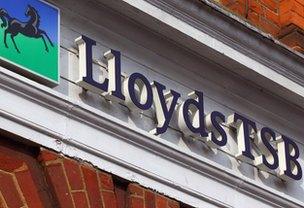Are banks taking dangerous mortgage risks?
- Published
- comments

After we learned in 2007 and 2008 that banks in general had far too little capital as a protection against losses on their loans and investments, you would probably think that by now it would be difficult to find examples of banks continuing to lend several hundred times the sums they hold in reserves to protect depositors and taxpayers against the risk of picking up the bill when borrowers default.
You might think that, but according to the banking team at Morgan Stanley you would be wrong.
In gripping and slightly alarming research published this morning, Morgan Stanley cites £143bn of high quality mortgages on the books of Lloyds - and it calculates that Lloyds holds just £314m of capital against the specific risk of these mortgages going bad.
In other words, Lloyds seems to have lent 455 times the value of the capital earmarked in its balance sheet to absorb losses, just in case these mortgages go bad. To put this in another way, just 0.2% of these mortgages would have to go bad for this capital to be wiped out.
Now Lloyds may be right that these really are the most succulent and prime of loans, where the probability of them going bad really is more or less zero.
But history, especially recent history, would probably remind us that by the time a bank has lent £143bn to any sector, the idea that there is a negligible risk of default is naive (at best).
The important question, however, may be how it is that Lloyds and the other big banks are allowed to lend such large multiples of their protective capital in the form of mortgages?
It is all down to our old friend, the Basel Rules, which attach risk-weights to different categories of loans. And in this instance, the culprit (if that is the right word) is the permission that was given under so-called Basel ll to the biggest banks to use their own internal risk models to determine the riskiness of categories of loans and - by implication - the amount of capital they need to hold as a protection against the souring of those loans.
The role of regulators, in this system, was to approve the risk models. But once that had been done, banks had discretion to decide the riskiness of different kinds of loans. And what won't surprise you is that banks' model all came to the conclusion that their own mortgages were significantly less risky than the standard Basel rules implied.
Just to remind you (needless I am sure), the current convention is that banks need in general to hold equity capital equivalent to around 10% of their loans. But this is not 10% of their gross loans and investments, but 10% of their loans adjusted for the putative riskiness of said loans.
So, for example, if all loans were perceived to be equally risky, then Lloyds would have to hold equity capital equal to 10% of that £143bn portfolio of high quality mortgages, or £14.3bn. But Lloyds believes that the probability of these loans going bad is negligible, as I have already mentioned, so its own regulator-approved risk model attaches a risk weight to the loans of 2.2%.
In other words, Lloyds - with the support of the Financial Services Authority - says that the risk-weighted value of these loans is just £3.14bn, and therefore it holds capital equivalent to 10% of that low number as a buffer to absorb losses on the entire £143bn gross value.
If you were to think that is slightly bonkers, you might not be alone.
Now this freedom given to banks to decide their own risk ratings, or what is known as the Internal Ratings Based Approach to determining capital, yields the following consequence for our biggest banks: they all hold relatively modest amounts of capital against their large books of mortgages.
So Lloyds, for example, attaches a risk weight of 16% on average against its entire book of mortgages. And in case you think Lloyds is being singled out as somehow taking an unusually optimistic view of the risk of mortgages going bad, that would be wrong.
According to Morgan Stanley, HSBC, Barclays, Santander and Nationwide all take a rosier view than Lloyds of the likelihood of default by homeowners. They respectively attach risk weights to their mortgage books of 15%, 15%, 14% and 11%. Only RBS, for reasons that are unclear, uses a much higher risk weight of 27% on its mortgage book.
Just to repeat, what that would mean is that when Nationwide, for example, lends £100,000, it attaches a risk-weighted value to that loan of £11,000 - and then holds capital equivalent to 10% of that £11,000, or £1100, to cover the danger of that loan going bad. Which would imply that Nationwide is frequently lending not far off 100 times the value of its capital.
Now the reason Morgan Stanley has been taking a keen interest in all of this is because of the noises coming out of the Financial Policy Committee - the new macro regulatory arm of the Bank of England currently working in an informal capacity but soon to have statutory powers - that the capital banks hold against mortgages is too low.
Or to put it in the jargon, the Bank of England may well try to reduce the so-called leverage in the mortgage market.
It would want to do this for three reasons:
It is not beyond the realms of possibility that the UK housing market could at some stage lurch downwards, foisting bigger losses on banks than their dedicated capital could absorb
When a category of loans, such as mortgages, benefits from such low risk weights, it can distort the economy, by giving incentives to banks to provide mortgages rather than other (potentially more useful) types of loans
If the housing market were ever to recover properly, the low risk weights could fuel another dangerous bubble
But there is a non-trivial problem with moving fast to remedy this alleged flaw. If banks were told, for example, to very rapidly increase their risk-weight for mortgages to the Basel standard of 35%, as has been recommended in Switzerland, they would either have to raise many billions of new capital (£17bn says Morgan Stanley), which would neither be cheap or easy right now, or - which is far more likely - they would simply shrink the amount of credit they provide in the housing market.
And at a time when a weak UK housing market is contributing to our economic malaise, a further tightening of credit conditions would be regarded as highly unwelcome by the Treasury - and it would go against the grain of government and Bank-of-England policy, in the form of their Funding for Lending scheme to provide more and cheaper loans to households and businesses.
So, as ever with the imperative of fixing what went wrong during the boom before the great crash of 2007-8, it is pretty obvious what needs to be done to provide a more stable financial system. Unfortunately, in the short term, the cure can hurt us all.
- Published15 October 2012

- Published3 October 2012
